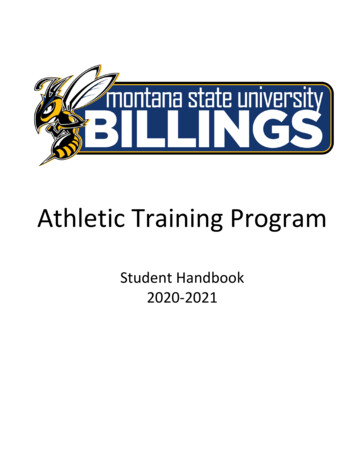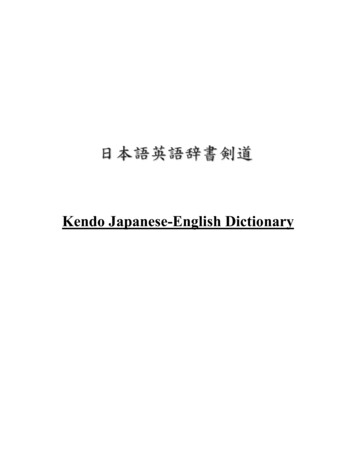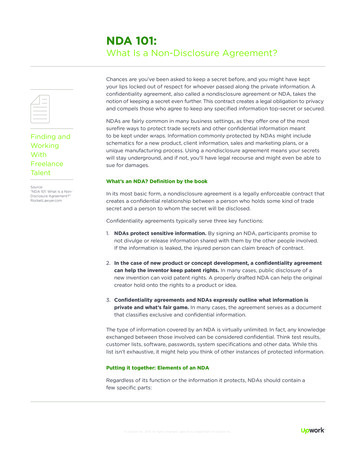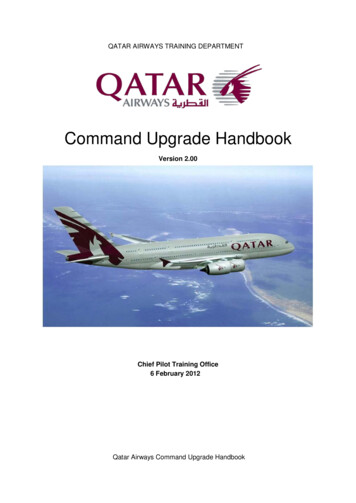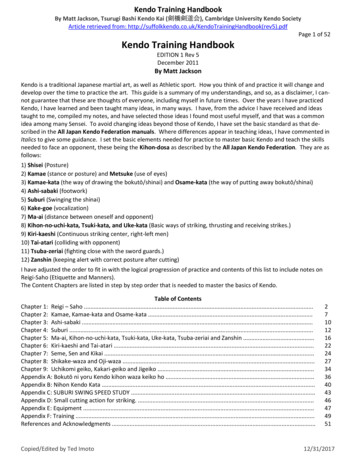
Transcription
Kendo Training HandbookBy Matt Jackson, Tsurugi Bashi Kendo Kai (剣橋剣道会), Cambridge University Kendo SocietyArticle retrieved from: v5).pdfPage 1 of 52Kendo Training HandbookEDITION 1 Rev 5December 2011By Matt JacksonKendo is a traditional Japanese martial art, as well as Athletic sport. How you think of and practice it will change anddevelop over the time to practice the art. This guide is a summary of my understandings, and so, as a disclaimer, I cannot guarantee that these are thoughts of everyone, including myself in future times. Over the years I have practicedKendo, I have learned and been taught many ideas, in many ways. I have, from the advice I have received and ideastaught to me, compiled my notes, and have selected those ideas I found most useful myself, and that was a commonidea among many Sensei. To avoid changing ideas beyond those of Kendo, I have set the basic standard as that described in the All Japan Kendo Federation manuals. Where differences appear in teaching ideas, I have commented inItalics to give some guidance. I set the basic elements needed for practice to master basic Kendo and teach the skillsneeded to face an opponent, these being the Kihon-dosa as described by the All Japan Kendo Federation. They are asfollows:1) Shisei (Posture)2) Kamae (stance or posture) and Metsuke (use of eyes)3) Kamae-kata (the way of drawing the bokutō/shinai) and Osame-kata (the way of putting away bokutō/shinai)4) Ashi-sabaki (footwork)5) Suburi (Swinging the shinai)6) Kake-goe (vocalization)7) Ma-ai (distance between oneself and opponent)8) Kihon-no-uchi-kata, Tsuki-kata, and Uke-kata (Basic ways of striking, thrusting and receiving strikes.)9) Kiri-kaeshi (Continuous striking center, right-left men)10) Tai-atari (colliding with opponent)11) Tsuba-zeriai (fighting close with the sword guards.)12) Zanshin (keeping alert with correct posture after cutting)I have adjusted the order to fit in with the logical progression of practice and contents of this list to include notes onReigi-Saho (Etiquette and Manners).The Content Chapters are listed in step by step order that is needed to master the basics of Kendo.Table of ContentsChapter 1: Reigi – Saho .Chapter 2: Kamae, Kamae-kata and Osame-kata .Chapter 3: Ashi-sabaki .Chapter 4: Suburi .Chapter 5: Ma-ai, Kihon-no-uchi-kata, Tsuki-kata, Uke-kata, Tsuba-zeriai and Zanshin .Chapter 6: Kiri-kaeshi and Tai-atari .Chapter 7: Seme, Sen and Kikai .Chapter 8: Shikake-waza and Oji-waza .Chapter 9: Uchikomi geiko, Kakari-geiko and Jigeiko .Appendix A: Bokutō ni yoru Kendo kihon waza keiko ho .Appendix B: Nihon Kendo Kata .Appendix C: SUBURI SWING SPEED STUDY .Appendix D: Small cutting action for striking. .Appendix E: Equipment .Appendix F: Training .References and Acknowledgments .Copied/Edited by Ted Imoto27101216222427343640434647495112/31/2017
Kendo Training HandbookBy Matt Jackson, Tsurugi Bashi Kendo Kai (剣橋剣道会), Cambridge University Kendo SocietyArticle retrieved from: v5).pdfPage 2 of 52Chapter 1: Reigi-Saho (礼儀作法)The Etiquette, Manners, and Attitudes below should be shown during Kendo training. Remember, in Kendo, the do (道)refers to the way or path to enlightenment, and as such, the attitudes should also be taken with you into everyday life.No matter what your experience or ability in kendo you can always show good reigi. Reigi is important because it helpsto maintain the relationship between the sword and the shinai. By showing such manners you are showing that you respect the fact you are dealing with a real sword and death is a very real possibility. Kendo is Japanese art, and if we failto maintain the Japanese identity of kendo, it will lose its meaning.Good Etiquette and Manners: Always ensure your toenails and fingernails are cut short before training. Always air your uniform and your armor after each session: never leave them in the bag between sessions or they willget moldy and smell horrible. Keep your uniform clean and fold it correctly before attending the session. Always check your shinai for splinters before attending the session. Do not wear shoes in the dojo. Remove all jewelers, including rings and watches before training. Show up early to practice. You shouldn't only just have time to get ready. You should help to prepare the dojo. It isusually the beginners' responsibility to clean the floor before and after every session. With a job or busy lifestyle thiscan sometimes be hard to achieve, but if you make an effort to do this, you will eventually understand the benefits.Don't use business or studies as your excuse to miss a session. Management of yourself is still part of your kendo. If you are late to practice, enter quietly, warm up and stretch, prepare yourself in seiza and join in from the end of theline. Always bow on entering and leaving the dojo. If you are warming yourself up before a session, you MUST stay in the shimoza. The kamiza is for your sensei and theshomen. Never enter it unless you are doing so to prepare the dojo for practice or are carrying sensei's gear for him.Usually, the half near to the entrance is the shimoza, and the other half is the kamiza. When you bring all your equipment into the dojo take up as little space as possible when you leave it at the side, makesure that it doesn't get in the way of the practice or the doors. Do not smoke, eat, drink or fool around in the dojo. Do not lean on a sword or rest a shinai or bokutō point downwards. Don't leave your shinai or bokutō in a way thatmeans they can fall over; they represent your swords which would be of great value. The blade and kensen of yourshinai and bokutō should point away from the Kamiza. If the dojo is small, then place your swords on the floor closeto the wall. Do not step over or kick a shinai on the ground. When you are asked to line up, this should be done quickly. KNOW YOUR PLACE IN THE LINE. The order in which youline up is the order of your responsibility in the group, not just your rank. Make it a habit of sitting in seiza quietly at the beginning and the end of the session. DON'T move about unnecessarily when you sit in seiza. You should sit with correct posture even if it starts to hurt.Controlling your posture and maintaining seiza even when it becomes uncomfortable is part of kendo. If you have aserious issue, swap to the cross-legged position but do not move again. If someone is kneeling in armor, you should pass behind them or, if you have to pass in front of them, bow and extendyour right hand in a vertical plane, palm forward. Follow the Sensei to whether Tenugui is laid over the Men or folded inside. If laid out, you should be able to read yourtenugui before you put it on. When you bow (shomen-ni, senseigata-ni, or otagai-ni) always bow longer than your seniors. Also if you are saying'onegaishimasu' or 'dōmo arigatō gozaimasu' say it correctly. When you put on your equipment (Men when we are in seiza, or Do after Kata practice) try to be the quickest. However, it is worse if you have to redo your equipment. Be quick but put the gear on properly. If your Men-himo is toolong, shorten them; if your Kote is untied, then tie them. During practice always bow correctly; 15 degrees maintaining eye contact.Copied/Edited by Ted Imoto12/31/2017
Kendo Training HandbookBy Matt Jackson, Tsurugi Bashi Kendo Kai (剣橋剣道会), Cambridge University Kendo SocietyArticle retrieved from: v5).pdfPage 3 of 52 During rotation you will have to pass quickly around the back of the sensei - DO NOT slow the whole practice down bybeing slow. Do not interrupt the teacher’s instruction, and do not chat with each other during practice. Save questions to whenasked or to after final rei. If you need to fix your bogu during a session then first ask your partner, move back out of the way and sit in seiza. If someone falls over in the dojo, unless it directly involves you, you should continue training. Don’t stop and crowdaround. Sensei will say if you have to stop, and if you are the first aider, be ready. Keep practicing unless you truly can't continue. It is reigi to keep going to get the most out of sensei; they will appreciate that you kept trying despite it causing you pain. Kendo practice means to train you, in other words, to make youfeel pain physically and mentally. Don't run away from this. Do not lean or lay down: stand, kneel or sit cross-legged when resting. It is reigi to be ready for practice; this means eating and drinking enough that you don't become tired and dehydrated.Drink enough before sessions, so you have the energy to continue, and don’t let the sensei, the dojo, and yourselfdown. If the weather is very hot, pay extra attention to fluid intake. If you are dehydrated and practicing for a long time insuch weather, you may get heat stroke. If you vomit or your feet bleed your first responsibility is to clean the dojo floor. After the dojo is cleaned, you cantake off Men and clean it, after which you can tend to yourself. Do not just stop practicing. If you cannot continue, tell your partner, excuse yourself to the sensei, take seiza and remove equipment in such a way as to not get in the way of practice. Only break for rest when invited to by sensei. Take that opportunity to drink fluids and check shinai and Bogu. Normally drinking will be outside Dojo, or in an assigned area. Bow if leaving the Dojo. Do NOT walk around the Dojodrinking! Take your Men off correctly: Pull the himo over your head and untie them there. Then take the Men off, holding it infront of your face until you have removed the tenugui. ALWAYS carry the visiting sensei's equipment for them; you should also fold it for them after the session. If you offerto do this, but they don't accept don't give up; offer again.Attitudes for Kendo: Always value the basics. Practice repeatedly and many times, practice with someone formidable Practice with the proper attitude. Practice with courtesy and respect. Do not be obsessed with winning; practice with the desire to study the principles of kendo. Have devotion to Kendo and practice with the initiative. Practice with determination. Value graceful, elegant, dignified Kendo. Be prepared physically and mentally, and then practice with eagerness. Know your capabilities and practice accordingly. Learn by experiencing. Always consider ways to improve. Be mindful of everyday life. Be conscious of safety. Be conscious of health and hygiene. Do not over-exhaust unreasonably beyond the limit. For students, consider how studies and Kendo can be balanced. Grasp the value of watching; humbly learn merits of others by observing. Always do warming up and cooling down exercises.Dojo: The term Dojo comes from Buddhism meaning "place to study," which originally referred to the platform Buddhameditated on. Commit yourself to sincere training when entering Dojo, appreciate having a place to practice and peopleto practice with, maintain cleanliness, and take care of your belongings neatly (e.g., shoes, clothes, Bogu).Copied/Edited by Ted Imoto12/31/2017
Kendo Training HandbookBy Matt Jackson, Tsurugi Bashi Kendo Kai (剣橋剣道会), Cambridge University Kendo SocietyArticle retrieved from: v5).pdfPage 4 of 52Know the location of Kamiza, the upper seat; this may be a shrine, flag or another symbol. The term Kamiza can bewritten in different Japanese characters which mean "upper seat" or "toward the altar." Beginners line up toward thelower end (Shimoza). Reigi is not just a quick bow entering the Dojo but is about Respect. Know how to bow correctly,and when, where and who to in the Dojo. They are not empty rituals but an expression of respect for all the othermembers of the dojo who are offering you a chance to practice kendo. Here is an extract from the Kendo Reader - written some 70 years ago: Make a reverend bow when entering and leaving the Dojo. Do not enter the Dojo dressed untidily; a Hakama should be worn if dressed in Japanese style. Maintain a respectful attitude and most correct posture. Be quiet and conscientious, do not engage in noisy chatter, laughter, clapping or cheering. After eating, allow a suitable amount of time to elapse before training. If you have taken alcohol, do not enter the Dojo; let alone engage in training. The sword is one’s soul, and the bogu is one’s armor. Handle them with respect according to the correct method. The Dojo interior must be cleaned morning and evening and kept tidy. Do not comment on other styles of swordsmanship or in each other’s technique. For those who are training in swordsmanship, take caution against shortness of temper or selfishness, do not be quarrelsome but always remain serene of heart.All senior students make sure the Dojo floor is safe, and tape/make any holes, etc., while juniors sweep the floor clean.Visiting other Dojo:If you are WEARING your Club’s Zekken, and visiting other Dojo, it is expected that you show CORRECT Reigi and set agood example. Always bow to the most senior Sensei (find out who it is), and introduce yourself and ask permission tojoin the class. Always try your hardest, and even if the ideas differ from what you have been taught, listen, try, learnfrom them - never argue or debate with your seniors. Some commands may differ – try to follow their way.About Rei: Rei is a way to pay respect and show acknowledgment. Upon entry to the Dojo, enter then Rei to theKamiza; this is a way to pay respect to the Dojo and to commit yourself to a sincere practice. Also, when exiting, Rei tothe Kamiza, then exit.Commands during TrainingAt the start will be:Sei retsu: line up in the correct order. You may hear Shinai o motte or Bokutō o motte - with Shinai or Bokutō.Chakuza: all sit down in SeizaShisei o tadashite: straighten back/sit up straightMokusō: a brief moment for meditationYame: stop mokusoShōmen ni rei: bow to the flag (Kamiza)Sensei (gata) ni rei: bow to the sensei (sensei’s)Otagai ni rei: bow to each other, and ask “please train with me” by saying; “Onegai shimasu.”Men o tsuke: put on men and kote. – seniors first when requiredAt the end of Practice will be:Sei retsu: line up in correct orderChakuza: all sit down in SeizaMen o tore: take off kote and menShisei o tadashite: straighten back/sit up straightMokusō: a brief moment for meditationYame: stop mokusoSensei (gata) ni rei: bow to the sensei (sensei’s) [NB: note slightly different order]Shomen ni rei: bow to the flag (Kamiza)Otagai ni rei: bow to each other and thank them very much: “Arigatou gozaimashita.”Acknowledge Sensei (teacher), Senpai (senior) and each other with Rei; this is to show respect and appreciation. Tosomeone senior, bow first and rise last. To each other, bow together simultaneously.Copied/Edited by Ted Imoto12/31/2017
Kendo Training HandbookBy Matt Jackson, Tsurugi Bashi Kendo Kai (剣橋剣道会), Cambridge University Kendo SocietyArticle retrieved from: v5).pdfPage 5 of 52Shizen-tai: Shizen-tai is natural posture which is the basis of all kendo postures and movements. The body should not feel strained. The face and eyes should face straight forward. Stretch the neck upward, and pull the chin back with a feeling of stretching the top of head to reach the ceiling.(There should be no gap between neck and Kendo-gi.) Shoulders are relaxed, with a feeling of being held slightly back. Arms should hang down naturally by your side, with fingers together. The hips are held straight, and lower abdomen held taut with a feeling of tightening the buttocks. Knees should not be bent, but relaxed, i.e., not completely straight legged (don’t lock your knees). The feet slightly apart, heels are drawn in, you should have your weight evenly applied.Ritsu-rei: There are two kinds of standing bow. The one to your opponent (moku-rei) and secondly, a formal bow,which we use bowing to the Shomen or sensei. The bow can be performed with or without a sword (shinai). The maindifference between them is the angle of the bow, and the eye contact.When entering or leaving the dojo, we perform a formal bow toward the Shomen or senior Sensei: Keep their body in shizen-tai position. Bend your body from the hip. Do not keep your eyes on them. You have tolook down. The angle of your body when you bow in this way is 30 degrees.When bowing to your opponent to perform the standard bow (moku-rei): Keep their body in shizen-tai position. Bend your body from the hip while looking at your opponent. Do not keepyour face straight toward your opponent. You want to keep your chin pulled in. The angle of your body is about 15degrees since you have to keep your eyes on your opponent.Your fingers should remain together, hand slightly on the front side of the leg. If you hold a Shinai, it should be at sageto, i.e., straight-armed by your side. When bowing with shinai, the angle of the shinai should not change.Seiza: Seiza is the formal kneeled sitting position. To assume seiza:1. Stand in shizen-tai.2. Draw back the left foot.3. Kneel down with the left knee next to the right foot, keeping heel up, and ball of the foot is touching the floor.4. Withdraw the right leg to a position next to the left leg with the heels up, and balls of feet are touching the floor.5. Tuck the toes of both feet under so the tops of the feet are touching the floor and the big toe of the right foot is overlapping the big toe of the left foot.6. Lower the hips to a fully seated position. Keep the upper body in correct posture with the hands placed naturally onthe thighs.Standing from seiza is the reverse of sitting:1. First, raise your upper body to a kneeling position.2. Raise your toes, so the balls of the feet are touching the floor.3. Step forward with the right foot, placing the foot next to the left knee.4. Push the legs straight to a standing position and then bring the left foot together with the right to end in shizen-tai.Main Points: Keep the upper body in correct, upright posture throughout the process of sitting or standing. While seated, your eyes cast forward. If listening to Sensei, turn your face toward the Sensei, not simply your gaze. The large toe of the right foot should be overlapping the large toe of the left foot. The knees should be separated by approximately 10cm. (the width one or two fists).Moku-soMoku-so is the act of composing one’s breath, posture, mind, and spirit while in the seiza position and is performed tostart and end the practice sessions. When performing moku-so, the hands are brought together to form an oval in frontof the abdomen. The fingers of the left hand overlap the fingers of the right hand, and the tips of the thumbs arebrought together under light pressure. The eyes are closed halfway, and deep breathing is performed. The tongueshould be resting on the top of the mouth, touching the back of the upper teeth.Copied/Edited by Ted Imoto12/31/2017
Kendo Training HandbookBy Matt Jackson, Tsurugi Bashi Kendo Kai (剣橋剣道会), Cambridge University Kendo SocietyArticle retrieved from: v5).pdfPage 6 of 52Main Points: The mind should be cleared of thoughts but kept fully alert (See below). Senseis say we should focus on our Kendogoals for the practice or to clear our minds by concentrating on breathing, counting the timing of the breathing cycle this will concentrate your thoughts. The eyes should remain slightly open. When the eyes are fully open or closed, the mind tends to remain active, thusmaking it difficult to perform moku-so correctly.I quote Zen Master Dogen (1200-1253), who stated in the Shobogenzo texts that we must keep our eyes “not so wideopen and not so narrowly closed.” Therefore, I relax my eyes naturally, focussed about 1 meter in front of me. Breathing:1. Breathe in for three seconds.2. Hold your breath for two seconds.3. Breathe out for 10-15 seconds.How to Breathe:1. Breathe in:Breathe in deeply through your nose, filling your lungs in about 3 seconds. As breathing in, the air goes down to aplace called seika-tanden (臍下丹田). Using our stomach or abdomen instead of our chest to inhale, we can take in alot more air. It is an image-training to think that the air goes down to the lower abdomen. Do not let your shouldersor chest rise during breathing. Chest breathing is not good for kendo as it will show our opponent when we arebreathing in, which it is a good opportunity for our opponent to attack us.2. Hold your breath:We do not breathe out the air right after breathing in. We hold the air inside us for a while. It is said that the airshould be held in seika-tanden, about three fingers down from your belly button. We hold the air in seika-tanden forabout 2 seconds.3. Breathe out:We breathe out through our mouth, slowly, not at once. It takes about 10 - 15 seconds to breathe out the air. Whenwe breathe out, we have to control the breathing. To do so, we have to use our abdominal muscles. (NB: Also the position of the tongue can help, relax it when exhaling.) After we breathe out, we can breathe in. Be focused on breathing out. Do not breathe out completely. Leave a bit of the air inside of you so you will not be out of breath. Try to breatheout for 10 seconds and gradually make it longer. Do not think about emptying your thoughts. By trying not to think about anything, you are already thinking. Sojust relax and concentrate on breathing. You may think about what you are going to improve in or have achievedduring training.That is the basic breathing. Some people may say the different duration of each action, but the duration mentionedabove of each action (inhale, hold, and exhale) seems a common idea. I have also been told that some old schools ofswordsmanship taught to count Zen breathing in 7’s - 7 second inhale, hold for 7 seconds, exhale over 7 seconds.Za-rei: Za-rei is the bowing from seiza. Like Ritsu-rei, za-rei has many levels of formality that are applied to its execution.1. Sitting in correct seiza, bend the upper body forward at the hips. At the same time, slide the hands forward over thethighs.2. As the bow deepens, merge the hands, creating a triangle with the index fingers and thumbs.3. At the deepest point of the bow, the back is parallel to the floor. The hands are flat on the floor with the triangularopening, between the index fingers and thumbs, directly below the nose.4. After holding the bow for a moment, raise the upper body back to the upright posture. At the same time, slide bothhands back to their original position.Main Points:a. When bowing, the back and neck should remain aligned, keeping correct upper body posture.b. Allowing the head to bob, especially allowing the chin to come to the chest exposing the nape of the neck to thekamiza or shinden is very poor form and impolite.c. As the upper body bows down, the eyes remain fixed, and the gaze follows down to the floor.d. The hips should not rise when the upper body bows downward.e. Exhale as the bow is performed.Copied/Edited by Ted Imoto12/31/2017
Kendo Training HandbookBy Matt Jackson, Tsurugi Bashi Kendo Kai (剣橋剣道会), Cambridge University Kendo SocietyArticle retrieved from: v5).pdfPage 7 of 52Chapter 2: Kamae, Kamae-kata and Osame-kataKamae: Kamae is the guard or ready posture employed for attack and defense. However, more than just a physical pose,kamae is also the on-guard posturing of the mind and spirit. These aspects of kamae, the body, and mindset, must always be practiced together. Equally important to keep in mind is that kamae begins and ends with proper etiquette.These points are never to be overlooked. There are three processes of kamae. They are assuming kamae, withdrawingfrom kamae and Kamae O-toku - kamae at-ease or open kamae. The legendary swordsman, Miyamoto Musashi (1584–1645) distinguished in his writings five primary guard postures collectively termed Goho-no-Kamae. In modern kendo,the goho-no-kamae continues to be the principal guard postures. The goho-no-kamaes are chudan-no-kamae, jodan-nokamae, gedan-no-kamae, hidari-waki-gamae, and migi-waki-gamae. Of the five, chudan-no-kamae (middle guard posture) is the first and most versatile of the guard postures. In modern kendo, chudan-no-kamae is the standard posturefrom which the other four kamae are instigated. Hasso-no-kamae is Kamae for eight directions (many enemies) andtreated as a special stance (?).Chudan no Kamae (Center Guard Posture): Left-hand grips at the end of Tsuka (hilt), placed in front of the navel, andright-hand grips near Tsuba (guard) but not touching it. The “V” shape between the thumb and index finger (Tora nokuchi) of both hands is over the top of the Tsuka. The left grip with last three fingers hold the Shinai, while the righthand with last two fingers lightly support it, Kensen is directed toward the opponent's throat. Tsuru (string) is up, rightfoot forward, the width of a foot between feet, left heel slightly off the floor, and left knee straight but not locked.Hand position: The anatomy of the hand includes the tora-kuchi. The tora-kuchiis the angle at the base of the index finger and thumb. The tora-kuchi and thetsuru or the seams of the tsuka-gawa [leather handle covering] are the keys topositioning the hands about the shinai’s circumference. The tsuru indicates theupright side of the shinai in its drawn attitude. In its correct configuration, thetsuru also marks the top centerline of the shinai. The hands should be positionedon the shinai in such a way that the top centerline of the shinai runs through theapex of the tora-kuchi of both hands. The left hand is positioned at the end ofthe tsuka, clasping the tsuka-gashira midway into the little finger. [NB: HoldingBokutō, the left hand should just reveal the tsuka-gashira]. The forward positionof the right hand is one-and-a-half fists ahead of the left hand. A common method for establishing the forward position of the right hand is to:a. Bend the right arm at the elbow.b. Place the hilt of the shinai in the joint of the right-hand elbow.c. Grasp the shinai with the right hand. Where the hand grasps the shinai withthe right hand is the location for the right hand.d. The right hand should almost touch the tsuba of the shinai (more than 2cm oftsuka space means it is the wrong length and needs adjusting).Tora no kuchiHand grip: The shinai should be gripped firmly, not tightly, as if holding an eggwithout crushing the shell. Both hands grip similarly, but the left grip should befirmer than that of the right hand. To grip the shinai:a. Extend the left hand as if reaching out to give a handshake greeting.b. Position the tsuka-gashira on the inside portion of the heel of the hand.c. Grasp the shinai firmly with the little and ring fingers.d. Grip the shinai with the middle finger using moderate (not tight or loose) pressure.e. The index finger and thumb remain relaxed.f. The right hand is positioned appropriately on the shinai, as previously outlined, and grips the shinai in the same manner as the left hand, with slightly less pressure.Main Points:1. Throughout the process of strikes and techniques, the hand positioning and grip should never change.2. The hands should not grip the shinai squarely. A square grip is usually the result of including the index fingers andthumbs in gripping the shinai. Such a grip will restrict the flexibility and movement of the hands.Copied/Edited by Ted Imoto12/31/2017
Kendo Training HandbookBy Matt Jackson, Tsurugi Bashi Kendo Kai (剣橋剣道会), Cambridge University Kendo SocietyArticle retrieved from: v5).pdfPage 8 of 523. The hilt of the shinai should be held at the very end (left hand). The overlapping of the small finger halfway over theend of the shinai is an acceptable practice. However, never is the shinai to be held with the hilt protruding from th
Kendo, I have learned and been taught many ideas, in many ways. I have, from the advice I have received and ideas taught to me, compiled my notes, and have selected those ideas I found most useful myself, and that was a common idea among many Sensei. To avoid changing ideas beyond those of Kendo, I have set the basic standard as that de-




